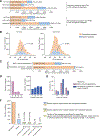Mapping the MHC Class I-Spliced Immunopeptidome of Cancer Cells
- PMID: 30425108
- PMCID: PMC12032831
- DOI: 10.1158/2326-6066.CIR-18-0424
Mapping the MHC Class I-Spliced Immunopeptidome of Cancer Cells
Abstract
Anticancer immunotherapies demand optimal epitope targets, which could include proteasome-generated spliced peptides if tumor cells were to present them. Here, we show that spliced peptides are widely presented by MHC class I molecules of colon and breast carcinoma cell lines. The peptides derive from hot spots within antigens and enlarge the antigen coverage. Spliced peptides also represent a large number of antigens that would otherwise be neglected by patrolling T cells. These antigens tend to be long, hydrophobic, and basic. Thus, spliced peptides can be a key to identifying targets in an enlarged pool of antigens associated with cancer.
©2018 American Association for Cancer Research.
Conflict of interest statement
Disclosure of Potential Conflicts of Interest
No potential conflicts of interest were disclosed.
Figures






References
-
- Coulie PG, Van den Eynde BJ, van der Bruggen P, Boon T. Tumour antigens recognized by T lymphocytes: at the core of cancer immunotherapy. Nat Rev Cancer 2014;14:135–46. - PubMed
-
- Liepe J, Ovaa H, Mishto M. Why do proteases mess up with antigen presentation by re-shuffling antigen sequences? Curr Opin Immunol 2018;52:81–6. - PubMed
-
- Vigneron N, Stroobant V, Chapiro J, Ooms A, Degiovanni G, Morel S, et al. An antigenic peptide produced by peptide splicing in the proteasome. Science 2004;304:587–90. - PubMed
Publication types
MeSH terms
Substances
Grants and funding
LinkOut - more resources
Full Text Sources
Other Literature Sources
Medical
Research Materials

